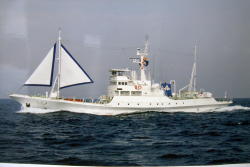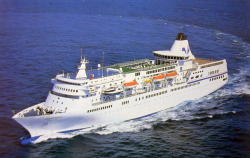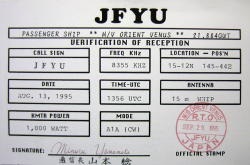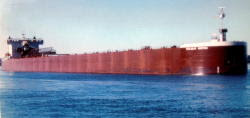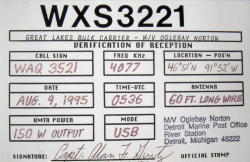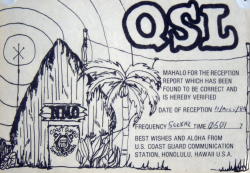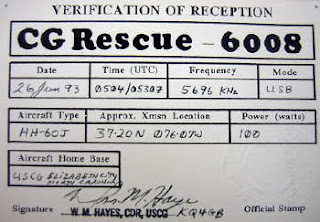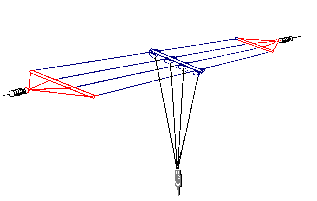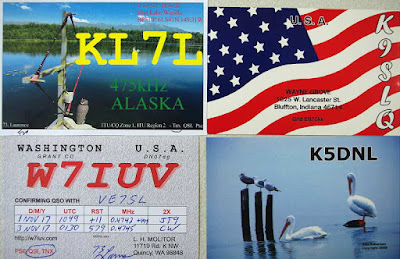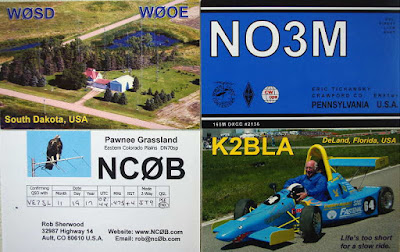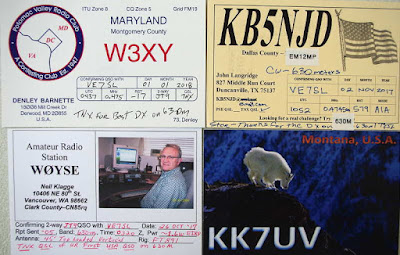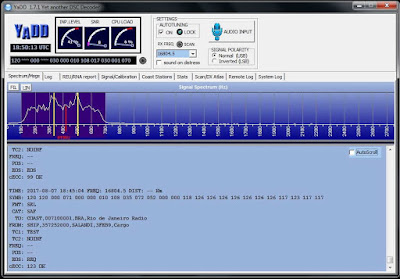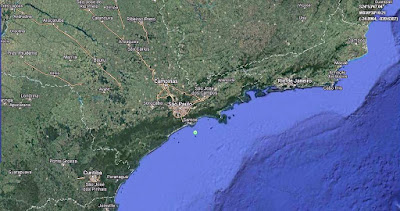Posts Tagged ‘QSLs’
 DXing The Utilities (Part 2)
DXing The Utilities (Part 2)
The following blog was originally posted in 2015 but might still be of interest to anyone with a shortwave radio! Since the migration of HF aero traffic to satellite has been slow, there is still a lot of oceanic traffic to be monitored on the bands, 24/7.
**************************************
Unlike the growing scarcity of good HF maritime DX targets, there is still a large amount of HF aero activity to enjoy! Even with the move to satellite comms, there is still, at any given time of the day or night, hundreds of aircraft using HF radio to communicate with controllers, companies and home bases. Both commercial aviation and the military, as well as many privately owned aircraft, use the HF communication networks to keep them flying safely. From trans-oceanic 777s' and military transports to single engine float planes in the Canadian Arctic and Alaska, the sky is alive with DXing opportunities!
A huge percentage of commercial aircraft are delegated to moving freight and many of them can be heard on HF radio. Many of the planes in use are retired passenger planes that have been reconfigured for moving cargo. Back when I did this type of listening, older DC-8s seemed to be particularly popular, especially on the nightly South / Central America to Florida routes. I suspect that nowadays, these have been replaced with older DC-10's and 747's.

'FINE AIR 432' was logged on March 24,1996 at 0435Z while working Miami Radio on 6637kHz. The DC8-51F (Freighter) was over Bogota while enroute from Lima to Miami.
 'NIPPON CARGO 083', a 747-200F, was logged
'NIPPON CARGO 083', a 747-200F, was logged
on 8891kHz working Baffin Radio. They were reporting position "LT", a waypoint above Alert, at 82-31N / 62-12W, westbound on Polar Track "Quebec".
The freighter was enroute Amsterdam to Anchorage.

The Antonov 124-100 is a gigantic Russian built freighter - capable of transporting in excess of
120 tons. This is aircraft "RA-82045" which was logged as 'HEAVYLIFT 878' in June, 1996.
Operated by Volga-Dnepr, 'HEAVYLIFT 878' was working Dakar (Senegal) Aeradio on 6535kHz reporting FL240 and position 13-14N / 24-26W enroute Cape Verde Islands to Sao Paulo, Brazil.
'AFM 01' was a DC8-55F logged while working Brazzaville Radio (Congo) on 8903kHz. It was at FL350, enroute Harare, Zimbabwe to Kano, Nigeria at the "MPK" waypoint, 250 miles east of Kinshasha, Zaire. Brazzavile was advising of 'crossing traffic, same level...please say intentions'... Yikes!
On another evening I heard the Dakar (Senegal) controller advise a British Speedbird 747 to 'go to flight level 330 ... please go now ... go very very fast'.
'AFM01' (Affretair) was Z-WMJ, shown here on final approach to Gatwick.
 'PACIFIC AIR EXPRESS 3517' was heard on 8867kHz working Brisbane Radio while over the Coral Sea. The Lockheed L-188C four-engine turbo prop was enroute Honiara to Brisbane with a load of fresh tuna destined for the Japanese market. N360Q, shown on the ground at Honiara, was leased from the states and operated by Charrak Air.
'PACIFIC AIR EXPRESS 3517' was heard on 8867kHz working Brisbane Radio while over the Coral Sea. The Lockheed L-188C four-engine turbo prop was enroute Honiara to Brisbane with a load of fresh tuna destined for the Japanese market. N360Q, shown on the ground at Honiara, was leased from the states and operated by Charrak Air.
 The U.S. military is still active on HF radio and some interesting catches can be had. During the testing phase of the 'cruise' missile, the missile navigation systems were tested over the Northern Territories and Alberta. Once dropped from their B-52 launch platforms, the missiles were tracked across Alberta by Advanced Range Instrumentation Aircraft (ARIA). 'AGAR 93' was heard on one such mission on 11176kHz. 'AGAR 93' was # 81-0893, an EC-18 (modified Boeing 707) out of Wright Patterson' 4950th Test Wing. According to the aircraft commander who signed my verification, the aircraft was approximately 1 hour S.E. of Namao, Alberta. One can easily see why # 81-0893, shown here, was affectionately known as "The Beast".
The U.S. military is still active on HF radio and some interesting catches can be had. During the testing phase of the 'cruise' missile, the missile navigation systems were tested over the Northern Territories and Alberta. Once dropped from their B-52 launch platforms, the missiles were tracked across Alberta by Advanced Range Instrumentation Aircraft (ARIA). 'AGAR 93' was heard on one such mission on 11176kHz. 'AGAR 93' was # 81-0893, an EC-18 (modified Boeing 707) out of Wright Patterson' 4950th Test Wing. According to the aircraft commander who signed my verification, the aircraft was approximately 1 hour S.E. of Namao, Alberta. One can easily see why # 81-0893, shown here, was affectionately known as "The Beast".
'DOOM 81' was a gigantic B-52H from the 96th Bomb Squadron, stationed at Barksdale AFB, LA. The appropriately named big bomber was heard on 11176kHz while working Ascension Radio and was just about to rendezvous with their mid-air refueler when the mission was aborted. This was the first and only B-52 that I was ever able to confirm.
 'ROMA 99' was logged on 17975kHz while working Thule Radio. They were taxiing for takeoff at Dulles International in Washington D.C. and reporting a minor fuel-pump problem. 'ROMA 99' was a KC-135R Stratotanker, # 62-003512, from the 509th Air Refueling Squadron at Griffis AFB, NY.
'ROMA 99' was logged on 17975kHz while working Thule Radio. They were taxiing for takeoff at Dulles International in Washington D.C. and reporting a minor fuel-pump problem. 'ROMA 99' was a KC-135R Stratotanker, # 62-003512, from the 509th Air Refueling Squadron at Griffis AFB, NY.
'REACH 71839' was heard on 11176kHz while working Albrook AFB, Alaska. Tail # 65-0239, this 'REACH' flight was an aging C-141B Starlifter, at one point, the Air Force's major transporter. 'REACH 71839', out of McChord AFB, was enroute Brazil to Puerto Rico.
There's still plenty to be heard on HF, outside of the amateur bands and a quick internet search on 'Utility DX' will turn up several interesting and informative sites ... each one having an abundance of related links to follow. Here are some that will be helpful:
**************************************
A freshly updated list of all active HF aero frequencies. Also check their list of active aero 'callsigns'
http://monitor-post.blogspot.ca/p/this-international-hf-aero-frequency.html
If you can catch an aircraft's four-letter SELCAL code, often given during waypoint checks, you can search here for more info on the actual aircraft itself:
http://www.airframes.org/reg/b18305
The Milcom Blogspot:
http://mt-milcom.blogspot.ca/
**************************************
Unlike the growing scarcity of good HF maritime DX targets, there is still a large amount of HF aero activity to enjoy! Even with the move to satellite comms, there is still, at any given time of the day or night, hundreds of aircraft using HF radio to communicate with controllers, companies and home bases. Both commercial aviation and the military, as well as many privately owned aircraft, use the HF communication networks to keep them flying safely. From trans-oceanic 777s' and military transports to single engine float planes in the Canadian Arctic and Alaska, the sky is alive with DXing opportunities!
A huge percentage of commercial aircraft are delegated to moving freight and many of them can be heard on HF radio. Many of the planes in use are retired passenger planes that have been reconfigured for moving cargo. Back when I did this type of listening, older DC-8s seemed to be particularly popular, especially on the nightly South / Central America to Florida routes. I suspect that nowadays, these have been replaced with older DC-10's and 747's.

'FINE AIR 432' was logged on March 24,1996 at 0435Z while working Miami Radio on 6637kHz. The DC8-51F (Freighter) was over Bogota while enroute from Lima to Miami.
 'NIPPON CARGO 083', a 747-200F, was logged
'NIPPON CARGO 083', a 747-200F, was loggedon 8891kHz working Baffin Radio. They were reporting position "LT", a waypoint above Alert, at 82-31N / 62-12W, westbound on Polar Track "Quebec".
The freighter was enroute Amsterdam to Anchorage.

The Antonov 124-100 is a gigantic Russian built freighter - capable of transporting in excess of
120 tons. This is aircraft "RA-82045" which was logged as 'HEAVYLIFT 878' in June, 1996.
Operated by Volga-Dnepr, 'HEAVYLIFT 878' was working Dakar (Senegal) Aeradio on 6535kHz reporting FL240 and position 13-14N / 24-26W enroute Cape Verde Islands to Sao Paulo, Brazil.
'AFM 01' was a DC8-55F logged while working Brazzaville Radio (Congo) on 8903kHz. It was at FL350, enroute Harare, Zimbabwe to Kano, Nigeria at the "MPK" waypoint, 250 miles east of Kinshasha, Zaire. Brazzavile was advising of 'crossing traffic, same level...please say intentions'... Yikes!
On another evening I heard the Dakar (Senegal) controller advise a British Speedbird 747 to 'go to flight level 330 ... please go now ... go very very fast'.
'AFM01' (Affretair) was Z-WMJ, shown here on final approach to Gatwick.
 'PACIFIC AIR EXPRESS 3517' was heard on 8867kHz working Brisbane Radio while over the Coral Sea. The Lockheed L-188C four-engine turbo prop was enroute Honiara to Brisbane with a load of fresh tuna destined for the Japanese market. N360Q, shown on the ground at Honiara, was leased from the states and operated by Charrak Air.
'PACIFIC AIR EXPRESS 3517' was heard on 8867kHz working Brisbane Radio while over the Coral Sea. The Lockheed L-188C four-engine turbo prop was enroute Honiara to Brisbane with a load of fresh tuna destined for the Japanese market. N360Q, shown on the ground at Honiara, was leased from the states and operated by Charrak Air. The U.S. military is still active on HF radio and some interesting catches can be had. During the testing phase of the 'cruise' missile, the missile navigation systems were tested over the Northern Territories and Alberta. Once dropped from their B-52 launch platforms, the missiles were tracked across Alberta by Advanced Range Instrumentation Aircraft (ARIA). 'AGAR 93' was heard on one such mission on 11176kHz. 'AGAR 93' was # 81-0893, an EC-18 (modified Boeing 707) out of Wright Patterson' 4950th Test Wing. According to the aircraft commander who signed my verification, the aircraft was approximately 1 hour S.E. of Namao, Alberta. One can easily see why # 81-0893, shown here, was affectionately known as "The Beast".
The U.S. military is still active on HF radio and some interesting catches can be had. During the testing phase of the 'cruise' missile, the missile navigation systems were tested over the Northern Territories and Alberta. Once dropped from their B-52 launch platforms, the missiles were tracked across Alberta by Advanced Range Instrumentation Aircraft (ARIA). 'AGAR 93' was heard on one such mission on 11176kHz. 'AGAR 93' was # 81-0893, an EC-18 (modified Boeing 707) out of Wright Patterson' 4950th Test Wing. According to the aircraft commander who signed my verification, the aircraft was approximately 1 hour S.E. of Namao, Alberta. One can easily see why # 81-0893, shown here, was affectionately known as "The Beast".'DOOM 81' was a gigantic B-52H from the 96th Bomb Squadron, stationed at Barksdale AFB, LA. The appropriately named big bomber was heard on 11176kHz while working Ascension Radio and was just about to rendezvous with their mid-air refueler when the mission was aborted. This was the first and only B-52 that I was ever able to confirm.
 'ROMA 99' was logged on 17975kHz while working Thule Radio. They were taxiing for takeoff at Dulles International in Washington D.C. and reporting a minor fuel-pump problem. 'ROMA 99' was a KC-135R Stratotanker, # 62-003512, from the 509th Air Refueling Squadron at Griffis AFB, NY.
'ROMA 99' was logged on 17975kHz while working Thule Radio. They were taxiing for takeoff at Dulles International in Washington D.C. and reporting a minor fuel-pump problem. 'ROMA 99' was a KC-135R Stratotanker, # 62-003512, from the 509th Air Refueling Squadron at Griffis AFB, NY.'REACH 71839' was heard on 11176kHz while working Albrook AFB, Alaska. Tail # 65-0239, this 'REACH' flight was an aging C-141B Starlifter, at one point, the Air Force's major transporter. 'REACH 71839', out of McChord AFB, was enroute Brazil to Puerto Rico.
There's still plenty to be heard on HF, outside of the amateur bands and a quick internet search on 'Utility DX' will turn up several interesting and informative sites ... each one having an abundance of related links to follow. Here are some that will be helpful:
**************************************
A freshly updated list of all active HF aero frequencies. Also check their list of active aero 'callsigns'
http://monitor-post.blogspot.ca/p/this-international-hf-aero-frequency.html
If you can catch an aircraft's four-letter SELCAL code, often given during waypoint checks, you can search here for more info on the actual aircraft itself:
http://www.airframes.org/reg/b18305
The Milcom Blogspot:
http://mt-milcom.blogspot.ca/
 DXing The Utilities (Part 1)
DXing The Utilities (Part 1)
The following blog was originally posted in 2015 but might still be of interest to anyone with a shortwave radio! Although maritime CW has all but vanished from HF, ships can still be logged and followed on digital modes, using DSC or Digital Selective Calling.
*******************************
 After building the house here on Mayne Island, in the early 90's, it was several years until I was able to set up a dedicated station. In the meantime, I limited my radio activities strictly to listening. I had a nice Icom R-71A set up in a hall closet and spent my radio-time, mostly on weekend evenings, listening to maritime CW, HF aeronautical traffic and, of course, NDBs below the broadcast band.
After building the house here on Mayne Island, in the early 90's, it was several years until I was able to set up a dedicated station. In the meantime, I limited my radio activities strictly to listening. I had a nice Icom R-71A set up in a hall closet and spent my radio-time, mostly on weekend evenings, listening to maritime CW, HF aeronautical traffic and, of course, NDBs below the broadcast band.My HF receiving antenna consisted of three inverted-V's ... one for 160m, the second for 80m and the third for 40m ... all fed from the same coaxial line at the top of a 70' Balsam. It didn't take long to realize what an exceptional radio location I had, living right at the edge of the ocean, with dozens of miles of saltwater in most directions other than due west.
I really enjoyed following evening airline flights across both the North and South Atlantic, and in the early winter afternoons, following the commercial air-traffic all over Africa. Even though listening on 5 or 6MHz, I was amazed at how strong the signals from airliners over Africa at 30,000 feet or more could become, this far to the west. In the early mornings, directions were reversed and traffic from the far east, right into India, was fairly common. Often, small single-engine planes, usually run by various missionaries, could be heard while on the ground, taxiing at remote field locations and calling in via HF radio to request takeoff and flight-following.
Now QSL's have always been one of my top radio interests and it wasn't long before I started sending and collecting verifications for both the aircraft and the ships I was hearing ... once I had figured out how to get my reception reports to their proper destinations.
A very small portion of my 'utility' QSL collection is shown below. For the most part, it consists of PRC's or 'Prepared Reply Cards', with blank portions to be filled-in by the verification signers. Surprisingly, my return rate was around 90% and verifications were often returned with long, hand-written letters and numerous photographs ... especially from the ship RO's, as I suspect their days at sea were often quite monotonous. Even many of the military and commercial aircraft pilots would return a handwritten note along with the filled-in verification card, which I found even more surprising. It seemed that most were very surprised to hear that their radio transmissions were even making it this far and could be heard so readily.
 Some of the most interesting catches came from the Pacific, with a large variety of ships operating out of Japan. There are probably still several maritime CW stations operating in Japan. Many of these were owned and operated by commercial fishing companies and could be heard working fleet vessels throughout the Pacific on their daily CW skeds.
Some of the most interesting catches came from the Pacific, with a large variety of ships operating out of Japan. There are probably still several maritime CW stations operating in Japan. Many of these were owned and operated by commercial fishing companies and could be heard working fleet vessels throughout the Pacific on their daily CW skeds.This interesting catch from the North Pacific was the Japanese 'fisheries research vessel' 'M/V FUJI MARU'. She was about 1200 miles NW of her CW contact, JNA in Tokyo.
A Japanese cruise-ship, the 'M/V ORIENT VENUS' was logged early one summer morning while working JNA on 8355 KHz CW. Her position indicates she was in the Mariana Islands.
One of my first catches from the Great Lakes
was the 'M/V Oglebay Norton', a huge bulk
carrier out of Detroit. Her 150W signal was loud and clear late one August evening while in contact with WLC, Rogers City Radio.
 The U.S. Coast Guard is still one of the best QSLers around.
The U.S. Coast Guard is still one of the best QSLers around.Several of their stations will QSL with a nice printed card.
NMC (San Francisco) and NMO (Hawaii) were two
catches, regularly heard on the old 500 KHz calling
frequency.
Stormy weather often provided a good chance
to catch a search and rescue mission in progress.
'Rescue 6008' was an HH-60J helo enroute from
Chesapeake Bay to Elizabeth City, North Carolina during
a midnight rescue operation.

Although not my farthest HF maritime catch,
this was one of the most surprising. 'C4PC'
was heard early one February evening on 8 MHz CW, when conditions seemed terrible. No other ships were heard on the band at the time. As I learned later, the 'M/V MAIROULI' was at anchor near Beirut, Lebanon, a distance of nearly 7,000 miles from Mayne Island.
.... cont'd
 630m … The New ‘Magic Band’?
630m … The New ‘Magic Band’?

The 'magic band' has always been associated with 50 MHz and its amazing propagation ... usually unpredictable and often without logical explanation. This past summer saw an explosion of digital FT8 activity on 6m which has, for me (and for others I suspect), eliminated almost all of the enjoyment I have found every year on this band.
With so much of the previous CW and phone activity now gone to FT8, the 'feel' of the band is just not what it once was. What I find puzzling is that so many have embraced this weak signal mode yet most of the two-way QSOs seem to be made between stations that can easily hear each other ... often at the very strong levels produced by 6m sporadic-E!
With FT8's inability to chat about antennas, rigs, propagation, locations or simply to exchange names, for me the magic has gone. Being able to hear signals build, fade up and down, or to experience the sudden arrival of bone-crushing signals from the east coast where none had existed moments earlier, is all part of what attracted me to 6m decades ago. I spent only a few hours on the band last summer, working a number of JA stations on FT8. No particular sense of satisfaction was garnered ... working a JA opening on CW is just way more exciting!
For many, the arrival of FT8 to the magic band has opened a whole new world and from seeing so many unfamiliar call signs on 6m this summer, it seems that FT8 has brought a lot of newcomers to the band. Unlike the JAs' worked every summer on CW, almost all of the FT8 JAs' sent their QSL immediately, with almost all excitingly indicating "1st VE" ... so this has to be a good thing! I suspect, that unless the level of conventional-mode activity returns to previous levels on 6m (highly unlikely), my interest in 50MHz will slowly wane or vanish altogether ... but thankfully, there's still magic to be found elsewhere on the ham bands!
As solar Cycle 24 draws down into its final months, the deep lows that were experienced at the end of Cycle 23 are starting to develop once again. For the past few weeks, propagation below the broadcast band has been the best it has been since the previous solar quieting.
Being just below the bottom edge of the broadcast band, 630m (472-479 kHz) has seen some of the benefits of the recent round of stagnant geomagnetic activity.
While some transcontinental QSOs are regularly being made on CW, most contacts are being completed using the weak signal JT9 QSO mode. Contacts can often be completed just as the sun begins to set and staying up into the wee hours to catch east coast DX is not a requirement. Over the past few weeks my 'states worked' total has climbed to 30 and with a couple of holdouts, the QSLs have been steadily arriving.
 |
| My 630m states worked, shown in red. Map courtesy: https://mapchart.net/ |
Last month's arrivals, in spite of the Canada Post delivery disruptions, are shown below.
The recent great propagation on 630m is well-demonstrated by last Saturday night's activity. For the previous two evenings, my JT9 CQ's (as well as QSOs) were being decoded for hours at a time by Rolf, LA2XPA in Norway. He was also hearing Larry, W7IUV, located a few hundred miles to my southwest, on the other side of the Cascade mountains in Washington state. Both of our signals would fade and trade places in Norway but often reaching audible CW levels! The problem was that neither myself or Larry could see any of Rolf's replies to us ... disappointing to us and frustrating for Rolf.
After an hour of trying, I asked Rolf (via the ON4KST LF chat page) what he was using for a receive antenna. It turned out that his secret weapon was a 1000' beverage pointed this way ... no wonder he was hearing so well. Larry, who was using a shorter, easterly pointing BOG (Beverage On Ground) for 630m receive, commented that he also had a 1000' beverage pointed toward Europe but it was optimized for 160m and doubted that it would work on 630. Just to make sure, he plugged it into a second receiver and soon indicated that he 'might' have seen a weak JT9 trace on the waterfall, close to Rolf's frequency.
One minute later Larry's comment was just "wow!" and the following minute he explained what had occurred. It seems that the 'possible weak trace' had suddenly skyrocketed to a -16db signal ... right at the edge of audibility! Larry and Rolf quickly exchanged signal reports and "RRs" as the first Europe-West Coast 630m QSO went into the history books ... 'wow' indeed!
Rolf reported that at his end, Larry's already good signal suddenly shot up to -5db, an easily copied CW level, before fading away for the night. Larry was pretty shocked at how quickly this strong short enhancement had occurred and we all hoped that the oft observed 'spotlight' propagation seen on 630 would move further west to VE7 ... but for now, it was not to be.
Earlier in the evening I had commented to Larry about some previous quirky 630m propagation and had suggested to him that it was probably just due to "the magic of radio" ... to which he politely dismissed with "sorry no magic, just hard work and dumb luck". Looks like he was right on both accounts, but after Saturday's excitement I think he may now believe in a little magic as well!
 Some Summer Short Wave Listening
Some Summer Short Wave Listening
 |
| courtesy:americanradiohistory |
Over the past few months I’ve spent some time tuning around the international shortwave bands.
I vividly recall how jam-packed these bands were when I first discovered the magic of radio, back in the peak years of Solar Cycle 19. Much has changed in this part of the radio spectrum since then, but after having read so many dire comments describing the demise of international SW broadcasting, I was pleasantly surprised at what I discovered.
Although there are certainly not the large numbers of stations there once were, there is still a large amount of activity to be found throughout the various bands allocated to international SW broadcasting.
 |
| courtesy: https://communicationwhiz.com/short-wave-radios-guide/ |
Trying to keep track of station schedules and frequencies is a hobby unto itself but now made easier with the availability of so many online information sources. As when younger, I found the best way to stay organized was to keep a SW logbook, eventually settling on a simple ‘diary’ format which is still evolving.
Its next refinement will be an additional notebook having separate pages devoted to each individual frequency within a given SW band. This will allow for updating frequency information from various postings of the daily online ‘heard’ reports.
I’ve always had a great interest in QSLs and collecting cards was one of the things that initially attracted me to SW radio back as a pre-teenaged DXer. For me, not much has changed in the last several decades and I still enjoy QSLs ... the real, traditional cards, as opposed to the now popular e-card. For me, an e-card just doesn’t have much appeal for some reason but for many others, they work just fine.
As I slowly re-learn much of what I had forgotten about SWL’ing, I discovered that there are still many SW broadcasters that will acknowledge a reception report with a real paper card ... just like the good old days!
If you are keen on doing some serious listening, I cannot recommend the WRTH highly enough.

Studying the latest WRTH revealed the QSL policies of most international as well as domestic SW broadcasters as well as contact information. It is a superb annual reference and well worth the investment! With this information in hand, my listening has become more focused on recording and submitting reception reports to those stations still practicing the courtesy of acknowledging reports with a traditional QSL. Many stations also issue an e-card, but these are of little interest to me at present.
With a small amount of spring-summer time devoted to SW listening, I generated and submitted a few reception reports along with linked audio files on my website ... so far, the following QSLs have arrived:
 |
| Radio Exterior de Espana |
 |
| 15520 kHz - Noblejas, Spain |
 |
| Radio Free Asia |
 |
| 9950 kHz - via IBB on Tinian Island, S. Pacific |
 |
| All India Radio (AIR) |
 |
| 9865 kHz - Bengaluru, India |
 |
| DX Clube Sem Fronteiras Broadcast via WRMI 7730 kHz, Miami |
 |
| T8WH - 9965 kHz Palau, South Pacific |
 |
| HSK9 - 5875 kHz Udon Thani, Thailand |
 |
| Radio Liangyou - Hong Kong |
 |
| 9275 kHz via Bocaue, Philippines site |
 |
| Radio Romania - 9730 kHz - Bucharest, Romania |
 |
| Radio Nikkei 2 |
 |
| 3935 kHz - Chiba, Japan |
I’ll do an upcoming blog on some of the great information and online sites to support international SW listening activities.
 Will The Sun Get Too Quiet For Topband DX?
Will The Sun Get Too Quiet For Topband DX?

Those of us that like to hunt European DX on 160m from the west coast know that the best time for this is during the 'solar low' years, those quiet periods between the end of one solar cycle and the beginning of the next.
From the west coast, openings to Europe on 160m are not something that happens with much regularity and, unlike the more frequent paths to Europe enjoyed from the east coast, are almost exclusively limited to this quieter part of the solar cycle. The weakening of the Sun's magnetic field at these times allows for less prop-killing D and E-layer signal absorption, particularly through the northern auroral zone path required from the west coast.
In his October, 2016, posting to the Topband reflector, propagation guru Carl Luetzelschwab, (K9LA), suggested that the coming years of solar lows may actually be too low and that because of the likely unprecedented low levels not seen in our lifetimes, the planet could receive higher cosmic-ray bombardment than normally associated with these periods.
"Since galactic cosmic rays are mostly *very energetic* protons, they can get down to low atmospheric altitudes, causing collisional ionization in the D region (and lower E region). A cursory estimate using cosmic ray ionization rates confirms more ionization in the lower atmosphere. 160m is not very tolerant of more absorption, so we may see an adverse effect of the weakened solar magnetic field."
K9LA's Topband comments seems to have its roots in his May, 2015 article, "What's Going On With-160 Meters?", where he compares the solar minimum period between Cycles 22 and 23 to the minimum years between Cycles 23 and 24. Carl noted that the best 160m propagation period that he had seen in his lifetime was during the years between Cycle 22 and 23 and pondered why, during the even deeper prolonged low between Cycles 23 and 24, was it not producing the same levels of great propagation observed 11 years earlier. One possibility he puts forward was that ...
" ... it involves galactic cosmic rays (GCRs). At solar maximum, the Sun is more active, causing more geomagnetic field activity that is believed to be detrimental to 160-Meter propagation. Coupled with the Sun being more active is the fact that the Sun's magnetic field is stronger, which shields the Earth from galactic cosmic rays. Going the other way, when we're at solar minimum, the Sun's magnetic field is weakest, letting in more cosmic rays."
His graph shows the yearly trend of only the low Ap index days (geomagnetically quiet) versus smoothed sunspot numbers for several recent cycles. The blue line plots the trend of low Ap index values with the black line showing the smoothed values; the red line indicates the smoothed sunspot number (solar activity levels).
 |
| source: http://k9la.us/May15_What_s_Going_On_with_160-Meters.pdf |
Carl's earlier observations indicating that the best 160m propagation he had ever observed was during the low period between Cycle 22 and 23 and not during the much quieter low period between Cycle 23 and 24 are very much different than my own ... perhaps because of our different locations.
From the west coast, the most challenging topband path is over the pole to Europe. This only occurs during 'best propagation' periods as this path will only open during prolonged periods of very low geomagnetic activity. Unlike Carl's path to Europe, west coast signals need to traverse the signal-killing auroral zone.
During the first low period, I did experience several openings to Europe but nothing compared to what they were during the second low period, between Cycles 23 and 24, the one Carl did not experience propagation as good as the previous low. For several winters in a row, during the 23-24 low, I often found night after night of amazing propagation to Europe, the quality of which I had never heard before. Interestingly, on almost all of these nights, there were no other signals on the band but Europeans and nearby Washington or Oregon state W7s ... no signals at all from the rest of North America. At times it mimicked the sound of 20m CW to Europe, with signals often reaching S9 on my FT-1000 S-meter. I even worked one SM station on CW while running just 10W output!
With this long intense low, cosmic ray bombardment should have been at an all time high ... maybe it was, but it didn't seem to be bothering the west coast path to Europe, via the seemingly dormant auroral zone.
I was prompted to address this topic after reading a recent report on the GeoSpace website, siting a new study led by Nathan Schwadron, professor of physics at the University of New Hampshire’s Space Science Center. In the study, recently published in the journal Space Weather, a publication of the American Geophysical Union, the researchers found that large fluxes in Galactic Cosmic Rays (GCR) are rising faster and are on a path to exceed any other recorded time in the space age.
The author's study predicted a 20% increase in radiation bombardment but their newest research shows current conditions exceed their predictions by about 10 percent, showing the radiation environment is worsening even more than expected.
With cosmic ray levels now predicted to increase by a whopping 30%, Carl and the rest of us may soon get some clarity on his original postulation that "maybe a solar minimum can be too deep for 160 meters."
With the next few cycles expected to be even poorer than the present one, the large increase in radiation levels from space may have profound impacts on more than just propagation ... satellites and, with a new appetite to return human activity to the moon, astronauts could be exposed to much higher radiation levels than ever before.
The next few years of (ultra?) solar-quiet should be very interesting!
 630m – Winter One
630m – Winter One
Although Canadian amateurs have had the 630m band for a few years now, the arrival of U.S. amateurs on the band last fall has been a game changer in terms of activity ... it's almost like starting fresh once again, hence the "Winter One" title!
The steady arrival of new stations on the band was exciting to see and the increase in activity made nightly band-checking mandatory in order to keep up with the new arrivals. Not totally unexpected, a high percentage of the new stations were located in the eastern part of the country where ham populations are higher, giving even more incentive to watch propagation trends for those 'special' nights to put some of the new arrivals in the log.
Over the winter DX season I worked 37 'new' U.S. stations in 23 different states. Of these 23 states, 11 were on CW while 12 were on JT9. Many of the JT9 contacts could have been made on CW at the time, had that been the operating mode chosen.
Hopefully the band will see an increase in CW activity next year as activity continues to grow. It is certainly much easier to get a capable CW signal on the air than a digital one and that is what many decided to do to get a quick start, while going the transverter route was the method chosen by most.
After being active all winter, the biggest surprise for me about 630m was just how little actual power is needed to exchange coast-to-coast signals, especially when using the weak-signal digital JT9 QSO mode.
Almost every new station that I worked was running less than 100 watts of total per output (TPO). A large number of these stations were in the 20 watt TPO range which I really found astounding, considering the relatively poor efficiencies of typical backyard antenna systems on this band. Propagation, always the great equalizer, was certainly playing a major role at times and watching conditions change from night to night was an education in itself.
As on most bands, allowable power is limited, but on LF and MF, the limits are stated in EIRP and not TPO. Hams are limited to 5W EIRP on 630m which may not sound like much but a large number of the stations worked this winter were worked while I was running around 2-3W EIRP which often seems to be plenty when using JT9.
Although Canada's west coast is now well-represented on 630m, it would be really great to see some interest and station building from provinces to the east ... VE6, VE5, VE4 ... The fast-approaching warmer weather should provide the ideal opportunity to get any needed antenna work squared away before the next DX season begins along with its anti-antenna building winter weather!
If you are one of many amateurs that may have been contemplating some 630m work but were discouraged about antenna sizes or having to generate gobs of power, hopefully the above information will encourage you to get on the band and join the fun.
You can find more information that may be helpful in your quest via the 630m links on the right side of my blog page or by clicking here.
The steady arrival of new stations on the band was exciting to see and the increase in activity made nightly band-checking mandatory in order to keep up with the new arrivals. Not totally unexpected, a high percentage of the new stations were located in the eastern part of the country where ham populations are higher, giving even more incentive to watch propagation trends for those 'special' nights to put some of the new arrivals in the log.
Over the winter DX season I worked 37 'new' U.S. stations in 23 different states. Of these 23 states, 11 were on CW while 12 were on JT9. Many of the JT9 contacts could have been made on CW at the time, had that been the operating mode chosen.
Hopefully the band will see an increase in CW activity next year as activity continues to grow. It is certainly much easier to get a capable CW signal on the air than a digital one and that is what many decided to do to get a quick start, while going the transverter route was the method chosen by most.
After being active all winter, the biggest surprise for me about 630m was just how little actual power is needed to exchange coast-to-coast signals, especially when using the weak-signal digital JT9 QSO mode.
Almost every new station that I worked was running less than 100 watts of total per output (TPO). A large number of these stations were in the 20 watt TPO range which I really found astounding, considering the relatively poor efficiencies of typical backyard antenna systems on this band. Propagation, always the great equalizer, was certainly playing a major role at times and watching conditions change from night to night was an education in itself.
 |
| K9MRI - 22W / 72' vertical wire / 140' tophat (72' x -140') |
 |
| K9FD/KH6 - 100W / 70' x 70' inverted-L |
 |
| K0KE (CW) - 75W / 70' x 50' inverted-L |
 |
| WA9CGZ - 100W / base-loaded 160m inverted-L |
 |
| N1BUG - 20W / inverted-L |
 |
| KC3OL - 15W / base-loaded 'T' |
 |
| K8TV - 3W eirp / 55' x 150' 'T' |
 |
| K9KFR - 20W / 80' wire vertical |
 |
| KA7OEI (CW) - 25W / 200' circular loop at 30' |
 |
| K5DOG - 16W / 275' vertical loop |
 |
| KC4SIT - 60W / inverted-L |
Although Canada's west coast is now well-represented on 630m, it would be really great to see some interest and station building from provinces to the east ... VE6, VE5, VE4 ... The fast-approaching warmer weather should provide the ideal opportunity to get any needed antenna work squared away before the next DX season begins along with its anti-antenna building winter weather!
If you are one of many amateurs that may have been contemplating some 630m work but were discouraged about antenna sizes or having to generate gobs of power, hopefully the above information will encourage you to get on the band and join the fun.
You can find more information that may be helpful in your quest via the 630m links on the right side of my blog page or by clicking here.
 YADD
YADD
 |
| Maritime Traffic - courtesy: www.marinetraffic.com/ |
Until very recently, I had believed that there were no longer any HF maritime operations left, other than various Coast Guard weather announcements and an emergency watch on certain USB frequencies.
Over the past week I have discovered that HF maritime activity is still alive and well, through the worldwide Digital Selective Calling (DSC) system, which has been around in one form or another since the early 90's as part of the Global Maritime Distress and Safety System (GMDSS) ... I guess I was just asleep at the switch, having not been aware of the HF DSC activity!
Although it's not CW, there's still ample opportunity to hear and follow global shipping traffic as vessels of all types contact coastal land stations or call each other. One requirement that keeps the DSC frequencies busy is the requirement for vessels to test their systems at least once per week, providing many opportunities to log various coastal stations or add a new ship to your logbook. Ships can be heard calling coastals for a routine signal test, setting up an SSB phone QSO on a specified frequency or just calling another ship for a test or a phone sked. As well, DSC can be used to send a distress message alert in times of emergency.
Messages are sent in an error-correcting FSK mode, similar to the Navtex system, using the same speed and shift of 100 baud /170Hz. There are a few programs that can be used to decode the DSC messages but one of the best and most popular is the freely available "YADD", by Dirk Claessens .
YADD stands for "Yet Another DSC Decoder" and is an offshoot of Dirk's equally popular and effective "YAND", a free Navtex decoder.
YADD and several other software decoders can be downloaded from the NDB List Info site ... the best source of hands-on information for topics involving NDBs, Navtex, DGPS, DSC DXing and more.
After downloading and installing YADD and setting audio levels correctly, YADD began decoding signals with ease.
The spectrum display at the top of YADD's screen shows the audio passband coming from the receiver. With the receiver in the CW mode, DSC signals will appear on the frequency that your receiver's BFO offset frequency is set for. I prefer an offset of 400Hz so the spectrum display shows the signal at 400Hz, with the tuning cursor centered on a signal. A narrow CW filter should also be selected but no narrower than 170Hz.
Each vessel using the system, as well as the coastal land stations, have a unique 9-digit MMSI number (Maritime Mobile Service Identity). Once the software detects the MMSI numbers being used, it can then display the vessel's name (or the coastal's location and distance) so you know who you are listening to ... it's all very slick!
After initially running my receiver for a few minutes on the 12MHz DSC channel, I decided to look up the location of the first two ships I had heard, using one of the Internet's marine traffic sites.
I was surprised to find that my first catch was a large tanker under way in Kola Bay, having just departed Murmansk, in the Russian Arctic. Vessel number two was also under way along the east coast of South Korea.
The YADD screen above is showing the large bulk carrier 'SALANDI' (3FEB9) calling Rio de Janeiro Radio (PWZ) today on 16804.5KHz.
 |
| Courtesy: Henk Guddee |
I soon discovered an active group of DSC DXers in Yahoo Group's DSC List, which I quickly joined and started asking a lot of questions. The 'Files' section also contains the latest list of ship MMSI numbers so that your YADD look-up text file can be kept up-to-date.
One of the group members, GM4SLV, has set up a wonderful website called YaDDNet devoted to collecting and posting listener's decoded loggings in realtime. One of YADD's features is the ability to automatically upload decoded signals, similar to PSK Reporter. It's an easy 30-second job to configure YADD to upload your spots to the net. His site also contains the latest MMSI look-up file used by YADD which is updated in real time from the latest log postings ... presently at 34,566 vessels!
Clicking on any of the uploaded ship names displayed in the real time YaDDNet log, automatically takes you to an online vessel-tracking site which usually has a picture of the ship along with all of its information, including its present position.
If you set up YADD to do some listening, I'd strongly urge you to also set it up so that your decoded spots are uploaded to the YaDDNet page in real time. Configuring this capability is very simple. Your latest logs will also keep the MMSI database up-to-date for all YADD users.
If, like me, you have missed the maritime CW activity on HF, you may find monitoring DSC traffic of interest ... both ships and coastals. I may even try QSLing some of the coastals again, many of which will still issue a traditional card QSL, upholding a long standing shortwave radio tradition ... but grab them while you can!
 |
| From my collection. Heard 4349KHz CW Aug '96 |








